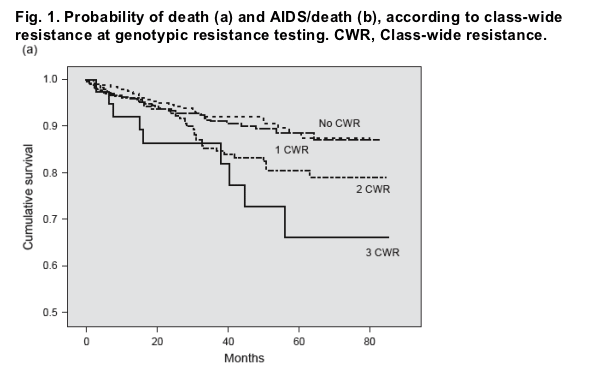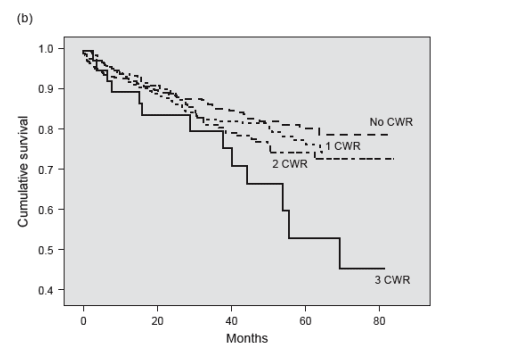| |
Continuous evidence of fast HIV disease progression related to class-wide resistance to antiretroviral drugs: a 6 year follow-up analysis of a large observational database
|
| |
| |
[Research Letters]
AIDS:Volume 21(13)20 August 2007p 1824-1826
Mauro, Zaccarellia; Federica, Forbicib; Patrizia, Lorenzinia; Francesca, Ceccherini-Silbersteinc; Valerio, Tozzia; Paola, Trotta Mariaa; Patrizia, Marconia; Pasquale, Narcisoa; Federico, Perno Carlob; Andrea, Antinoria
aClinical Department, National Institute for Infectious Diseases 'Lazzaro Spallanzani', Rome, Italy
bVirological Department, National Institute for Infectious Diseases 'Lazzaro Spallanzani', Rome, Italy
cDepartment of Experimental Medicine, University of Rome 'Tor Vergata', Rome, Italy.
Abstract
Class-wide resistance (CWR) was increasingly associated with a higher risk of HIV progression after 72 months of follow-up among 1392 patients genotypic-tested after failure (AIDS risk 13% for no CWR to 34% for three CWR; AIDS/death risk 21-54%). At multivariate analysis, the detection of two and three CWR was significantly associated with a two and threefold increased risk, respectively, of death and AIDS/death, suggesting that extended resistance is a marker of disease progression in long-term observation.
The latest HIV treatment guidelines consistently recommend the use of resistance testing after treatment failure, in order to make a better assessment of the salvage combination antiretroviral regimen [1,2]. Improved survival was recently shown to be associated with the regular use of resistance testing [3]. Moreover, in our experience, class-wide resistance (CWR), particularly if extended to more than one drug class, was associated with both an increased risk of virological failure [4] and HIV disease progression and death over a 4-year observation time [5].
Other recent reports observed correlations between wide resistance and HIV progression. In a large north American cohort, the onset of drug resistance was associated with an increased risk of death among patients starting antiretroviral therapy in 1996-1999 [6]. In Europe, the progression of HIV infection was found to be more rapid for patients with mutations related to resistance to all three classes of antiretroviral drugs [7]. In a large European cohort in which the combination of a high number of resistance mutations and triple class failure predicted mortality, extended resistance strongly reduced the therapeutic options and was associated with further treatment failures [8].
For none of these studies was the observation monitored for a period longer than 5 years, an important timepoint in view of strategies designed to control the long-term progression of the disease. Therefore, also in light of new drugs recently available and of new updates about resistance mutations [9], we evaluated the long-term effects of CWR in our extended cohort of patients failing antiretroviral therapy.
A database of 1392 HAART-failing patients, who underwent genotypic resistance testing (GRT) between 1999 and June 2005, was analysed. Patients were followed up to May 2006.
The GRT was performed using the Viroseq (1 and 2) HIV-1 genotyping kit and the 3100 ABI Sequencer (Applied Biosystems, Foster City, California, USA).
At GRT, a complete clinical history for each patient was collected, including demographic characteristics and laboratory results.
In order to define the level of genotypic resistance in each patient, CWR for each of the three main antiretroviral classes was assessed, adapting the International AIDS Society - USA criteria [9], if: three main mutations for nucleoside reverse transcriptase inhibitors among M41L, E44D, K65R, D67N, K70R, L74V, V118I, M184V/I, L210W, T215Y/F, K219Q/E, Q151M, 69ins; three main mutations for protease inhibitors among D30N, V32I, L33F, M46I/L, I47V/A, G48V, I50L/V, I54L/M, L76V, V82A/F/T/S, I84V, L90M; one mutation for non-nucleoside reverse transcriptase inhibitors among L100I, K103N, V106A/M, Y181C/I, Y188L, G190S/A were detected.
The GRT-guided therapy after failure is routinely determined within a working group that is active in our Institute, including clinicians and virologists. The group discusses the clinical cases and the results of the GRT weekly to decide jointly the best salvage regimen.
After GRT, patients were also followed over time to evaluate the progression of HIV disease. Time to death by any cause or new AIDS event/death were considered analysis endpoints.
Patients included were distributed as follows: men 68.9%; median age 39.5 years [interquartile range (IQR) 35-44]; risk groups: intravenous drug users 33.9%, heterosexual transmission 30.8%, homosexual behaviour 16.3, other/not reported 19.0%; Centers for Disease Control and Prevention (CDC) class C at GRT 37.1%; median number of pre-GRT treatments three (IQR 2-5).
The distribution of CWR at GRT was: nucleoside reverse transcriptase inhibitors 443 patients (31.8%); non-nucleoside reverse transcriptase inhibitors 407 patients (29.2%); protease inhibitors 155 patients (11.1%). Moreover, 375 patients (27.9%) harboured one CWR, 252 patients (18.1%) two CWR and 42 patients (3.0%) three CWR.
Over a median of 28 months of observation (IQR 13-51), 124 (8.9%) patients died, whereas 86 of them (6.2%) experienced a new AIDS-defining event after GRT.
The crude proportions of death and AIDS/death were higher among patients with three CWR compared with the other groups (21.4 versus 8.5%, P = 0.004 and 31.0 versus 14.6%, P = 0.004 at chi-square test, respectively).
At 72 months of follow-up, the risk of death increased, in correlation with the extension of CWR at GRT (Fig. 1): 13% for no CWR, 12% for one CWR, 21% for two CWR and 34% for three CWR, as well as with the risk of AIDS/death: 21% for none, 27% for one or two and CWR 54% for three CWR.


A multivariable analysis with Cox proportional hazard model was performed adjusting the effect of CWR over survival by demographic (sex, age, HIV transmission) and clinical variables (CD4 cell count, HIV RNA and CDC C at GRT, number of pre-GRT treatments). The calendar year of GRT was added to the analysis to measure the effect of the improved treatment over time. The hazard ratio (HR) was calculated using no CWR as a reference group. A progressively higher HR of death related to the increased number of CWR observed: one CWR: HR 1.1, 95% confidence interval (CI) 0.6-2.2, P = 0.8; two CWR: HR 2.2, 95% CI 1.2-4.2, P = 0.014; three CWR: HR 3.3, 95% CI 1.3-8.2; P = 0.009.
Thus, the detection of two or three CWR was significantly associated with a two and threefold increased risk of death, respectively. CDC C at GRT (HR 2.0, 95% CI 1.2-3.4; P = 0.01) was also significantly associated, whereas a higher CD4 cell count (HR 0.7, 95% CI 0.6-0.8, P < 0.0001, per 100 cells) was inversely associated.
Moreover, a similar finding emerged using AIDS/death as the endpoint: one CWR: HR 1.5, 95% CI 0.9-2.5, P = 0.095; two CWR: HR 2.0, 95% CI 1.2-3.3, P = 0.012; three CWR: HR 2.9, 95% CI 3.4-6.1, P = 0.005). Similarly to the previous case, CDC C at GRT (HR 3.1, 95% CI 2.0-4.8; P < 0.0001) was significantly associated, whereas a higher CD4 cell count (HR 0.8, 95% CI 0.7-0.9, P < 0.0001, per 100 cells) was inversely associated.
Altogether our results show a significant effect of CWR over the progression of HIV disease, even for prolonged follow-up and despite the availability of new drugs (belonging to the classic three anti-HIV classes) and of enfuvirtide (effective, but difficult to manage on a long-term treatment). Therefore, even in the presence of this new clinical scenario, the detection of extensive resistance can be still considered a negative prognostic marker of HIV disease.
These data support the view that the mere availability of new drugs is not sufficient per se to warrant a long-term clinical success in multifailing patients. This outcome is challenged by the upcoming availability of drugs belonging to classes different to those so far available (integrase inhibitors, entry inhibitors, etc.), which might completely modify this scenario. The avoidance of the development of CWR currently remains crucial to the long-term success of antiviral therapy.
|
|
| |
| |
|
|
|